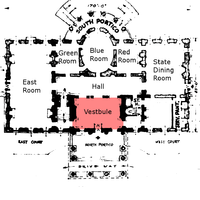Vestibule (architecture)

A vestibule /ˈvɛstɨbjuːl/ is a lobby, entrance hall, or passage between the entrance and the interior of a building.
The same term can apply to structures in modern or ancient Roman architecture. In modern architecture vestibule typically refers to a small room or hall between an entrance and the interior of the building or house. In Roman architecture, vestibule (Latin: vestibulum) referred to a partially enclosed area between the interior of the house and the street.[1]
Modern usage


In contemporary usage, a vestibule constitutes an area surrounding the exterior door. It acts as an ante-chamber between the exterior and the interior structure. Often it connects the doorway to a lobby or hallway. It is the space one occupies once inside the door, but not yet into the main interior of the building.
Although vestibules are common in private residences as a modified mud room, they are especially prevalent in buildings designed to elicit a sense of much grandeur, such as government buildings. The residence of the White House in the United States is just such an example. It contains a vestibule between the entrance at the north portico and the main interior hall. Many government buildings mimic the classical architecture from which the vestibule originates.
A purely utilitarian use of vestibules in modern buildings is to create an "air lock" entry. Such vestibules consist of merely a set of inner doors and a set of outer doors, the intent being to reduce air infiltration to the building by having only one set of doors open at any given time.
ATM vestibule
An ATM vestibule is an enclosed area with automated teller machines that is accessible from the outside of a building, but typically features no further entrance beyond the vestibule. There may be a secure entrance to the vestibule which requires a card to open.[2]
Railroad use
The vestibule on a railroad passenger car is an enclosed area at the end of the carbody, usually separated from the main part of the interior by a door, which is power-operated on most modern equipment. Entrance to and exit from the car is through the side doors, which lead into the vestibule. When passenger cars are coupled, their vestibules are joined by mating faceplate and diaphragm assemblies to create a weather-tight seal for the safety and comfort of passengers who are stepping from car to car. In British usage the term refers to the part of the carriage where the passenger doors are located; this can be at the ends of the carriage (on long-distance stock) or at the 1/4 and 3/4 of length positions (typical on modern suburban stock).
Ancient usage
Vestibules were common in ancient Greek temples. Due to the construction techniques available at the time, it was not possible to build large spans. Consequently many entrance ways had two rows of columns that supported the roof and created a distinct space around the entrance.[3]
In ancient Roman architecture, where the term originates, a vestibule was a space between the interior of a building and the street. The structure was a mixture between a modern hall and porch. Upon entering a Roman house or domus, one would have to pass through the vestibule before entering the atrium.[4]
From the 5th century on vestibules were used in Christian churches in both the east and west.[5]
See also
- Genkan
- Propylaeum
- Vestibule at Wiktionary
References
- ↑ Vestibule. The Oxford English Dictionary. http://www.oed.com Online edition, December 2006
- ↑ Kovacs, Eduard (7 February 2012). "Fraudsters Install Skimmer on ATM Vestibule Door". Softpedia. Retrieved 13 December 2013.
- ↑ Tarbel, F.B. "A History of Ancient Greek Art.". Retrieved 2006-03-02.
- ↑ McManus, Barbara. "Sample Plan of a Roman House". VRoma. The College of New Rochelle. Retrieved 2006-03-02.
- ↑
 "Vestibule (Porch)". Catholic Encyclopedia. New York: Robert Appleton Company. 1913.
"Vestibule (Porch)". Catholic Encyclopedia. New York: Robert Appleton Company. 1913.
| ||||||||||||||||||||||||||||||